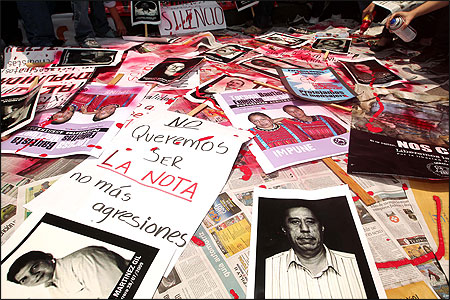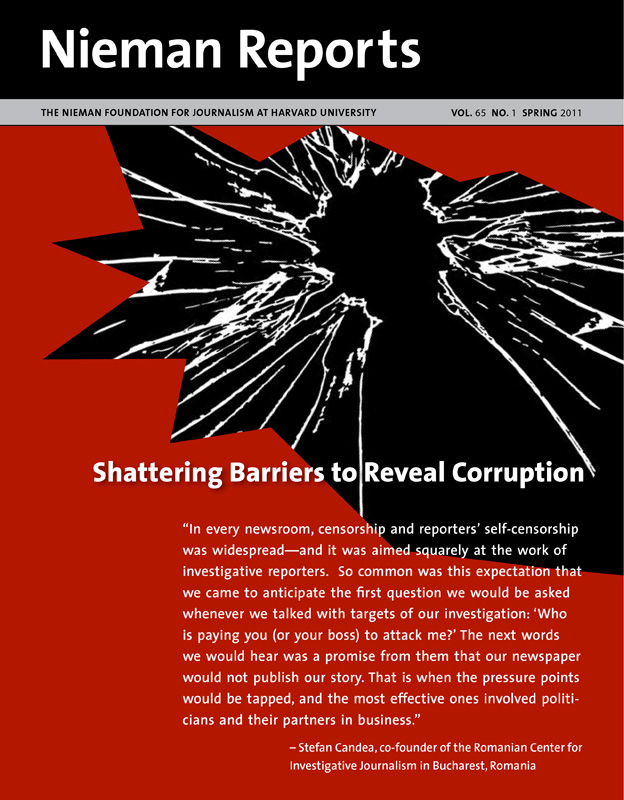
On August 7, 2010, protesters left pictures of dead and missing journalists at the Interior Ministry in Mexico City as a display of their anger at the killing and disappearance of reporters, editors and photographers. Photo by Christian Palma.
RELATED ARTICLE
“Statistics on Impunity”
- Elia Baltazar and Daniela PastranaMexican journalism today is an extensive compilation of anecdotes about violence in a climate of corruption. For most journalists, the days pass in terms of simple math: One has to add up the sums of the murdered and the injured, the executed, the civilian casualties, the drug traffickers, the police officers and military soldiers killed in confrontations or ambushes, the forcibly disappeared. In this tally, however, the numbers of journalist victims are not particularly taken into account. Journalists in Mexico have been assassinated, kidnapped or held captive for a few hours, a few days, or even months. Some return, and we are still looking in vain for others.
Almost nothing is known about the journalists who have been murdered, forcibly disappeared, or kidnapped. Files about them accumulate in neglected government drawers, and their cases are slowly forgotten because journalists in Mexico have to take responsibility for their own fate and security.
RELATED LINK
Resources for Investigative ReportersEven now, in the worst violence that the Mexican press has ever faced, there are very few who maintain an interest and even fewer who make timid efforts to guarantee the free exercise of journalism, freedom of expression, and the right of citizens to be informed. Thus, reporters, photographers and even editors shoulder the responsibility for their own security. And the government moves at a snail's pace to develop a mechanism for the protection of journalists that does not even encompass representatives of organizations that defend freedom of expression, making the argument that these individuals are not part of the profession. Nor has any mechanism of doing so involved media companies, which up until now have set themselves apart from the daily risks that journalists face.
Este artículo está disponible en Español.The national press has observed the attacks on the regional and local press with scorn, and its passivity has only been overcome in a few cases that involve it directly, such as the July 2010 kidnapping of three journalists from Televisa and Milenio TV. That event stirred up the collective indignation of a profession that up to this time had to mourn its dead victims by themselves and who faced a total lack of interest for its kidnap victims.
For the first time, journalists' social networks from all over the country spawned a movement still active on Facebook and Twitter. With a hashtag as a prefix, we baptized the movement Los Queremos Vivos ("We Want Them Alive") and we used this slogan to generate a protest with the participation in Mexico City—by our count—of some 2,000 marchers, including journalists, citizens, students and even some government officials. Other protests took place in 14 cities throughout the country. As of today, Los Queremos Vivos has become the trademark for the denunciation of attacks against the press. Journalists from civic organizations and every state share information in the spaces on social networks that have become a virtual wall of warnings and debates about the violence.
This movement—propelled by social media—has come to fill a vacuum in professional organizations. But it is not a formal representation of the profession nor does it pretend to be; it is merely a symbol of unity demonstrating our own integrity, dignity and rights as journalists.
Pending Tasks
The first steps taken by Mexican journalists in their own self-defense have aroused other concerns and needs. Today the priority is life: To survive in those parts of Mexico where violence is escalating, some journalists have bowed to pressure from the cartels and stayed silent about the drug trade and corruption it spawns. The locals call this "narcojournalism."
However, it is not fair to talk about self-censorship. Journalists keep quiet in many regions because organized crime obliges them to do so or an investigation could cost them their lives. And they do so because journalists vary in their abilities and level of professional development. In spite of this, there are individual and collective efforts by the media, with reporters and photographers determined to break the imposed silence and continue their work, training themselves in both self-protection and the use of investigative tools.
Since last year when we declared ourselves war correspondents in our own land, we have captured the attention of international organizations that have supported our training efforts. But it has not been easy. Journalistic investigation finds its path blocked by organized crime and even worse, by the government itself, which has invoked its ability to keep information secret and to mark it as classified, limiting the reach of federal and local laws that guarantee transparency. Information is increasingly classified as confidential as a matter of national security.
Appeals to force the government to open up their files are also increasingly common. These procedures can take weeks, but time is at a premium to Mexican journalists, many of whom work long hours and with extensive multimedia duties that keep them on an endless rolling deadline filing for the newspaper, Internet, television and radio. Moreover, many of them have no job security; in Mexico, we lack even basic information about the labor conditions of journalists. And the media are not particularly inclined to sponsor professional training programs nor are there journalists' organizations that promote it. Everyone does what he or she can with the support of offerings at some universities and nonprofit organizations such as Journalists on Foot (Periodistas de a Pie), the Press and Democracy Foundation (Prensa y Democracia, Prende), and the Inter American Press Association (IAPA). Others look for training outside the country if their newspaper's resources permit.
Given the lack of support and professional capacity to undertake investigative journalism, which only a few reporters manage to do and often it is done outside of office hours, narrative journalism is the vehicle that many bet on. But it is not enough. Until now, cases of corruption exposed by journalists have been very few and have taken limited advantage of technological resources. Let it be stressed that there are exceptions to this rule. If we wish to guarantee the quality of democracy in the future, the problems of Mexican society demand a type of journalism that reveals and pulls information out of the structures of illegal power and corruption.
Elia Baltazar is co-editor of Excelsior, a newspaper, and Daniela Pastrana is a correspondent within Mexico for the Inter Press Service. They co-founded Journalists on Foot (Periodistas de a Pie), which promotes the professionalism of journalists, and Los Queremos Vivos ("We Want Them Alive"), which gives journalists a platform to speak out about freedom of expression and to denounce attacks against journalists. They were involved in organizing the protest demonstration of journalists in Mexico City on August 7, 2010. June Carolyn Erlick, editor in chief of ReVista: Harvard Review of Latin America, translated this article.




